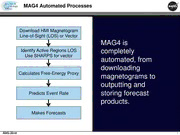
NASA Technical Reports Server (NTRS) 20160000978: An All-clear Space Weather Forecasting System Based on Magnetogram in near Real Time An All-Clear Space Weather Forecasting System Based on Magnetogram in Near Real Time PDF
Preview NASA Technical Reports Server (NTRS) 20160000978: An All-clear Space Weather Forecasting System Based on Magnetogram in near Real Time An All-Clear Space Weather Forecasting System Based on Magnetogram in Near Real Time
National Aeronautics and Space Administration SCIENCE & TECHNOLOGY OFFICE An All-Clear Space Weather Forecasting System Based on Magnetogram in Near Real Time David Falconer, Nasser Barghouty, Igor Khazanov, and Ron Moore Jan 11, 2016 http://www.uah.edu/cspar/research/mag4-page www.nasa.gov Outline 1. MAG4 background 2. Measurement 3. Effectiveness 4. Transitioning to Vector 5. Future improvements Bastille Day (2000 July 14) Flare, Coronal Mass Ejection and Solar Energetic Particle Event AMS 2016 2 MAG4 Automated Processes Download HMI Magnetogram Line-of-Sight (LOS) or Vector MAG4 is Identify Active Regions LOS completely Use SHARPS for vector automated, from downloading Calculates Free-Energy Proxy magnetograms to outputting and storing forecast Predicts Event Rate products. Makes Forecasts AMS 2016 3 MAG4 Science Background • Flares and CMEs are known to be drivers of the most severe space weather • Flares and CMEs typically originate in active regions (aka sunspots) • Flares and CMEs are examples of exceptionally large explosive releases of magnetic energy stored in the corona • While the amount of free energy cannot be measured directly, free- energy proxies can be measured • Event rates have been shown to be correlated with the magnitude of the free-energy proxies AMS 2016 4 What is MAG4? • MAG4 (Magnetogram Forecast), developed originally for NASA/SRAG (Space Radiation Analysis Group), is an automated program that analyzes magnetograms from the HMI (Helioseismic and Magnetic Imager) instrument on NASA SDO (Solar Dynamics Observatory), and automatically predicts the event rate (or probability) of major flares (M- and X-class), Coronal Mass Ejections (CMEs), and Solar Energetic Particle Events • MAG4 does not forecast that a flare will occur at a particular time in the next 24 or 48 hours; rather the probability of one occurring! • GONG (Global Oscillations Network Group) magnetograms, can be used instead as a backup but at a lower forecast accuracy • Present cadence of new forecasts: 96 minutes (60 minutes for CCMC) Vector magnetogram actual cadence: 12 minutes AMS 2016 5 R2O Timeline of MAG4 • 1973 The MSFC (Marshall Space Flight Center) vector magnetograph was built to support Skylab • 2000-present MSFC used vector magnetograms to study CME correlation with free- energy proxy • 2007-12 A DOD/Multidisciplinary University Research Initiative/Neutral Atmosphere Density Interdisciplinary Research helped support funding of the basic research • 2008 Partnered with JSC/SRAG (Space Radiation Analysis Group) and won an R20 NASA/Technical Excellence Initiative grant: Began building a database that grew to ~40,000 magnetograms of ~1,300 active region, covering years 1996-2004 with event catalog from SOHO/MDI (Solar and Heliospheric Observatory/Michelson Doppler Imager) observations • 2010-present NASA’s HEOMD (Human Exploration and Operations Mission Directorate) support • 2010 SDO is launched began transitioning from MDI to HMI line-of-sight magnetograms. • 2011 MAG4 installed at SRAG a NRT (Near-Real-Time) forecasting tool, and SRAG began pre-operations testing • 2012 Provided NOAA web access to MAG4 NRT forecasts • 2013 Improve MAG4 so that it can use a combination of free-energy proxy and previous flare activity • 2015 Transition to HMI line-of-sight to vector magnetograms AMS 2016 6 Calculating the Free-Energy Proxy A magnetogram of an active region • When the transverse gradient of the vertical (or line-of-sight) magnetic field is large, there is more free- energy stored in the magnetic field • For each Active Region: The integral of the gradient along the neutral line is the free-energy proxy Neutral Line, color coded for gradient 500 G 0.1G/km -500 G 0 G/km AMS 2016 7 Converting Free-Energy Proxy to Predicted Event Rates 1 10 100 10 100 10 100 Forecast Curves Free-Energy Proxy W(kG) These empirical forecast curves are used to convert our free-energy proxy into predicted event rates. Curves are derived from a sample of 40,000 magnetograms, from 1300 active regions observed between 1996-2004. AMS 2016 8 Identifying Active Regions • Magnetograms are spatial maps of the magnetic field NOAA ARs 06-Mar-2012 14:23 strengths 11423 11426/3 11429/5 • They come in two basic types 11430/6 Best LOS 11431/1 Accuracy - line-of-sight (right) - vector magnetograms NOAA Active • Free-energy proxies can be Regions measured for Active Regions (ARs) (areas with sunspots) from either type of magnetogram • Line-of-sight magnetograms suffer reduced accuracy further from disk center A full-disk line-of-sight magnetogram of the Sun, from SDO/HMI. Magnetograms & identify ARs AMS 2016 9 Forecast Multiplicative uncertainty example NOAA ARs 06-Mar-2012 14:23 11423 Rate 1 sigma Probability 11426/3 Events/day 66% Confidence 11429/5 11430/6 0.02 0.01-0.05 0.7-5% 11431/1 0.7 0.3-1.9 20-80% For a Multiplicative Uncertainty of 2.7x 2012/03/06 14:23 MAG4 Forecast # AR# WL Lng Lat 24 Hour Event Rate Dist SG (kG) (deg) M&X CME FCME X SPE (deg) 3 11428 9 -21 -17 0.020 0.020 0.009 0.002 0.003 27 5 11429 65 -41 17 0.700 0.400 0.200 0.100 0.080 44! 6 11430 11 -25 20 0.020 0.030 0.010 0.004 0.005 32! 1 11431 1 36 -27 0.000 0.001 0.001 0.000 0.000 45! Disk Forecast Rates 0.800 0.400 0.200 0.100 0.090 Multiplicative Uncertainties 2.7x 2.1x 2.2x 3.0x 2.4x Disk All-Clear Forecast Probabilities 50.00% 70.00% 80.00% 90.00% 92.00% Uncertainties 40.00% 20.00% 10.00% 10.00% 7.00% AMS 2016 10
